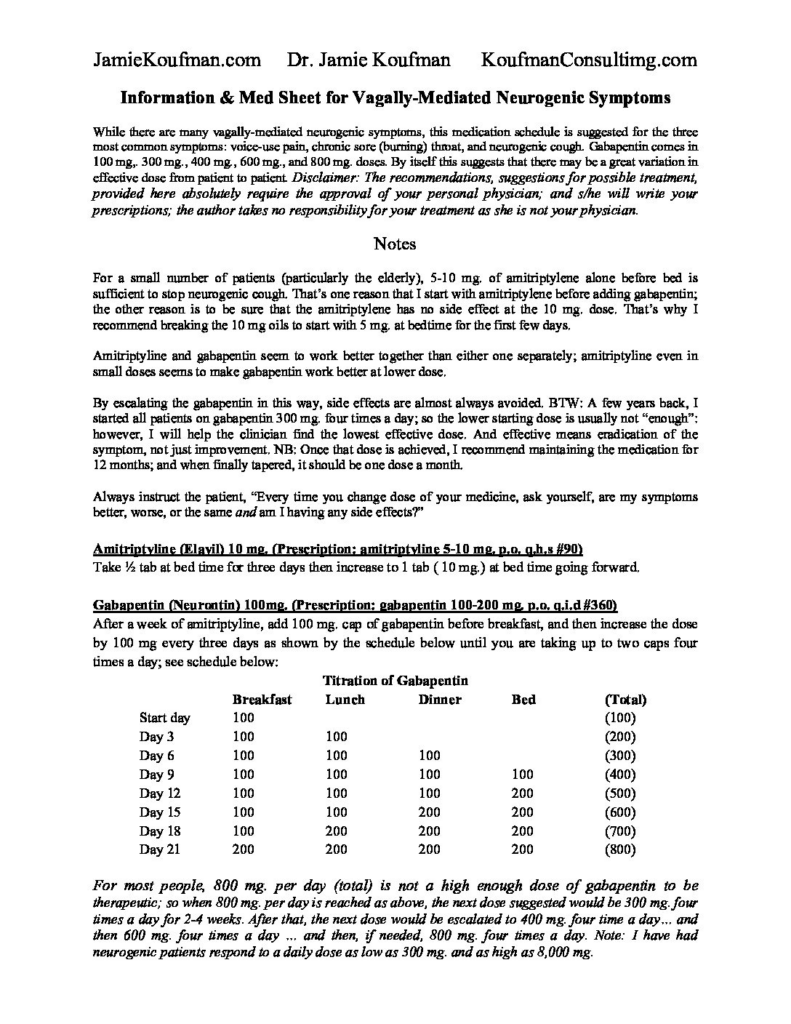
Dr. Koufman’s Treatment for Three Vagally-Mediated Neurogenic Symptoms: Painful Speaking, Chronic Sore Throat, and Cough
At-A-Glance
- The vagus nerves (plural vagi) are the main nerves for the respiratory, digestive, and cardiovascular systems and for the viscera (internal organs).
- After the vagi exit the skull, they enter the neck, and run just below the lining membrane of the throat at the back, behind the tonsils. There they can be damaged by injury or infection.
- Vagus nerve injuries are common; however, neurogenic (sick-nerve) symptoms are relatively uncommon; this blog covers Dr. Koufman’s primary treatment of three neurogenic conditions: painful speaking, chronic sore (burning) throat, and cough.
Note: This information is provided without any liability to the author; you use this information at your own risk; whether your physician chooses to use this protocol or not, it is between you and your doctor.
The vagus nerve is the tenth of twelve cranial (from the cranium) nerves, and it is the most important nerve in the body. The vagi (plural vagus) control the aerodigestive (respiratory/digestive) system as well as the cardiovascular system and the viscera (internal organs) … cut both of them, and you’re dead.
Vagus nerve damage by injury or infection can result in neurogenic (sick-nerve) symptoms. This post pertains to Dr. Koufman’s treatment schedule using amitriptyline and gabapentin for three specific syndromes; (1) painful speaking, aka voice-use pain or odynophonia; (3) chronic, sore (burning) throat, and neurogenic cough.
The primary purpose of this post is to offer specifics on the manner in which I escalate amitriptyline and gabapentin, which has not been previously reported.
Chronic Sore Throat
The word sore might not be correct here, because most people with this condition have burning throat. It’s clearly not infection since these people have it day in and day out, week in and week out, for months or years. The pain can be intense enough to disrupt normal life. Again, the keyword is burning; and by the way, this can also rarely be esophageal burning pain.
Painful Speaking
Painful speaking is also caused called voice-use pain and odynophonia. This occurs following a vagal neuropathy and is particularly problematic for singers, actors, teachers, clergy … for vocal professionals. Voice-use pain is also usually accompanied by vocal fatigue, effortful speaking, and voice change. Virtually all of these patients have vocal for paresis parentheses partial paralysis of one or both vocal cords; although, if the findings are subtle, they may be missed by clinicians. The common misdiagnosis here is muscle tension dysphonia, and indeed laryngeal biomechanics are altered, but altered to achieve glottal closure.
Neurogenic Cough
Neurogenic cough usually goes along with reflux-related cough as well; and in my opinion, the reflux should be addressed before neurogenic cough is treated. In general, neurogenic cough is a dry cough, and it occurs with fumes, change of temperature like going into air conditioning, and with voice use.
Treatment
It has been my experience that amitriptyline and gabapentin work better together than either one separately … but only a small amount of amitriptyline is needed. By the way, amitriptyline is an old time antidepressant called Elavil; however, the amount that I recommend (5-10 mg.) would not make a fly happy. This is being given for a vagally-mediated neurogenic problem, not for anxiety or depression.
Gabapentin has been my drug of choice for the treatment of nerve-related problems for decades. There is a newer version of it called a pregabalin or Lyrica, but there’s no evidence that this new drug is any better than a gabapentin. And it is easier to titrate gabapentin because it comes in a wide range of doses: 100 mg., 300 mg., 400 mg., 600 mg., and 800 mg.
The key is to find the smallest effective dose that eradicates the symptom. If, for example, a problem is neurogenic cough, improving the cough is not enough. The drugs must be adjusted so that they eradicate the symptom.
It is worth noting that I usually leave patients with neurogenic symptoms on that medication cocktail for a year after the symptoms have abated, because if you stop the medication too early there may be a recrudescence of the symptom. It is as though it takes year for the brain stem nucleus to recognize the neurogenic afferent is bogus. I’ve taken the liberty of providing a PDF of the medication schedule below, which are you should be able to print.

PRINT PDF … For more information about your neurogenic problem, consider scheduling a virtual consultation with me, you can book appointment online.










